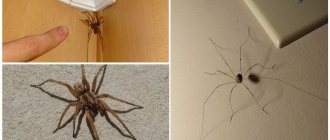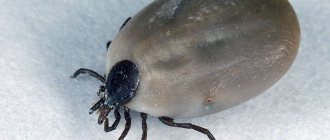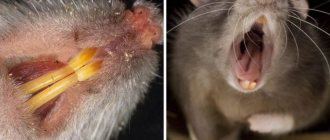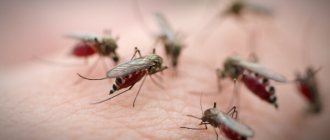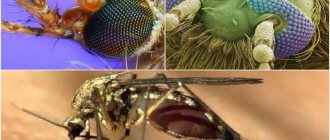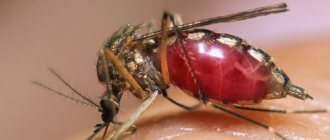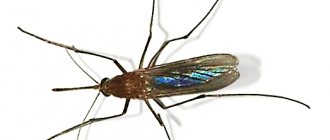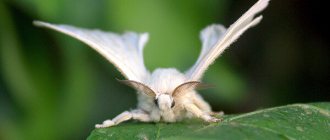What does a wasp look like?
The wasp can be mistaken for its closest relative, the bee.
Wasps belong to the order Hymenoptera. This also includes bees, bumblebees, and ants. But wasps have a number of differences; in other articles we talked about bees and their characteristics. Today we will look at interesting facts about wasps. The structure of the wasp's body makes it clear why these insects are classified as the suborder of stalked bellies. The thorax and abdomen of the wasp are separated, appearing in two parts. The beautiful narrow waist of girls and women is called the “wasp waist” precisely for this reason.
Important: Thanks to the structure of the wasp, the popular expression “wasp waist” came about, personifying the slimness and beauty of the female figure.
The wasp hardly thinks about the beauty of her body, but such a structure gives her other advantages. For example, due to its anatomical structure, a wasp can effortlessly sting its victim from any angle. This helps the wasp win fights with other, larger insects.
You can unmistakably identify a wasp by its bright color. The insect's body is divided by black and yellow stripes of bright color. This type of wasp is most often found in our latitudes; the family is called paper wasps. But there are other types of wasps, for example:
- Burrowing wasps
- Spangled wasps
- Typhia
- Road wasps
- Scolia
- Hornets
Not all wasps are black and yellow. Spangled wasps are emerald in color with a metallic sheen. Road wasps are black with red spots, less often they have white or yellow spots. Typhus wasps are dark in color with reddish legs. The sizes of wasps can also be different:
- Typhias reach sizes of 1-1.5 cm;
- Giant wasps can have a body length of 3 to 5 cm;
- Spangles are small, body length no more than 1.5 cm;
- Paper wasps are the same size as bees.
- Hornets reach sizes of 2.5-3 cm.
Depending on the species, wasps lead a different way of life; they can live in tree hollows or burrows. Below are photos of different types of wasps.
Spangled wasp
Road wasp
Typhus wasp
This is what a hornet looks like
general information
All wasps differ in size and are divided into subspecies. Not only can they sting painfully, but they can also benefit people.
Types of wasps
Few people know that every year these winged predators save hundreds of tons of farm crops around the world, exterminating hordes of pests of all varieties. Wasps are part of the order Hymenoptera, which contains tens of thousands of species. They tend to lead a social lifestyle. There are the following subfamilies of wasps:
- Scolia. They are one of the largest representatives of Hymenoptera insects. On average they are 6 centimeters long. Their wingspan can reach 10 centimeters. The color of skolia is dark with yellow and red splashes.
- Sand. Wasps of this species do not hunt spiders; their prey is insect larvae and aphids. They usually hide in earthen holes.
- Typhia. Representatives of this species tend to parasitize other insects. They usually lay their eggs in the bodies of various beetles.
- Hornets. Representatives of this group are large individuals. Their wingspan is 8 centimeters, and their body size reaches almost 6 centimeters. Since they kill a huge number of pests, they are considered beneficial insects for farms.
- German women. A distinctive feature of this species is the thick hair, which is found only in females. For this they were nicknamed velvet ants.
- Floral. Individuals of this species are considered the smallest among all hymenopteran insects. Their length never exceeds 1 centimeter. They eat pollen from flowers.
- Road. Representatives of this group usually measure about 3-4 centimeters. They prefer a solitary existence and hunt mainly spiders. They are even able to defeat large tropical species. They lay eggs in their prey.
- Sparkles. Each such subfamily has its own species. They got their name for their beautiful golden color. They can parasitize not only other insects, but also their fellow insects.
Typical habitats for wasps are the middle and southern stripes of the globe. They are found both in coniferous forests and in the tropics. The suitable temperature for them is from 12 to 40 degrees Celsius.
Features of reproduction
The life of a wasp swarm lasts only for one summer. The construction of cells begins in the summer, and the female lays one egg in each of them. This camera is well sealed. All individuals can reproduce independently. As soon as the offspring matures, they fly away from the nest forever.
Those insects that live in families have a queen, which is responsible for the construction of the hive. Each individual goes through a development cycle lasting one month. A larva emerges from the egg, which turns into a pupa, and from it an adult develops. Over the course of several years, a wasp swarm can number about a thousand insects.
Wasps. Do they benefit people?
If you are stung by a wasp, it will be painful, and your body may react incorrectly. The composition of wasp venom is almost no different from bee venom. After long studies of toxic substances, scientists have established that wasp venom is more allergenic and more often causes dangerous allergic reactions in the body. As you already understand, we will talk about the effect of wasp venom on a person through a bite.
Is there any benefit from a wasp sting? Can the poison have a beneficial effect? Let's look at the benefits of a wasp sting for humans.
It is impossible to answer unequivocally. Due to the fact that bee and wasp venoms are similar in composition, those who like to use bee products as medicine think that a wasp sting is as beneficial as a bee sting, and their venom can help against diseases.
If we follow this hypothesis, then the only difficulty before the practical use of wasp toxic substances in medicine is that the raw materials are very difficult to obtain.
Bees are specially bred and their venom can be obtained in large quantities in the apiary using a well-established method, and you will have to go to the found nest for the wasp venom. Second option: organizing mass construction of nests is possible.
Scientists have studied the poisonous substances of the wasp and imagine how they behave with various organs and tissues. The effect of the poison, its usefulness or damage directly depend on the reaction of the organism itself to the bite.
In the end, even doctors and toxicologists have not made a final decision on whether wasp stings are beneficial.
The poison contains many stimulating and tonic components, substances that stimulate metabolism, but their isolation is difficult and unreasonable, because now safer analogues can be found on the market.
In addition, thanks to wasps, there are fewer insects that eat fruits or plants. They exterminate pests such as aphids, flies, fleas, caterpillars, bedbugs and others. One individual can destroy up to three dozen pests per day.
And yet, does wasp venom bring benefits or not? A bite will not bring any benefit to a person. But doctors officially use wasp venom. It is used in the manufacture of special vaccines for those susceptible to allergies and in products that are intended to reduce sensitivity to poisons and bites.
And in Europe, scientists are researching wasp venom as a drug that can treat cancerous tumors. And there remains hope that they will one day achieve a positive result.
Wasp venom can do more harm than benefit. It contains allergenic components that are unsafe for the human body. These substances may lead to:
- to increased temperature and mild malaise;
- to difficulty breathing;
- to urticaria;
- to inflammation and swelling;
- to a headache.
The damage from a wasp sting also lies in the sensitization it can cause. This is an increased sensitivity to subsequent bites. In other words, when the first bite causes a serious reaction, subsequent bites will lead to severe complications and death. A large number of bites leads to subcutaneous hemorrhage, necrosis and damage to internal organs, and kidney failure may occur.
In the most severe cases, a wasp sting may be accompanied by confusion and Quincke's edema. The bitten area will begin to rapidly swell, and if at first the size of the tumor is small, then later they increase, and the entire limb may swell.
The worst and main danger of a wasp sting is anaphylactic shock. This is how the organisms of people who are very sensitive to wasp venom react. A person can die due to anaphylactic shock. It develops at an incredible speed; most often the patient does not have time to be brought to the hospital.
What can you do to alleviate the consequences and not cause yourself even more harm?
- wash the bite area;
- carefully remove the sting;
- disinfect the wound;
- apply ice to the damaged area;
- take any antihistamine.
There is little benefit from a wasp sting, but it can cause harm. How it will act and what consequences it will incur depends on how susceptible the body is to insect bites. In most cases, the bite will be accompanied by simply unpleasant or painful sensations.
- Don't confuse wasps and bees. The latter bring honey, therefore they are considered very useful insects for people. And wasps are predators, so they don’t bring honey, but eat flies, caterpillars and other insects. Their main benefit is that a person can study their life from a scientific point of view. Each type of insect is useful for humans in this regard.
- There can be no doubt, wasps are useful, wasps bring honey, wasp honey is tasty and healthy. In nature, everything is interconnected, every animal, insect, etc. fulfills its function and role. In addition to honey, wasps pollinate flowers and plants.
- In nature, every insect, plant, animal necessarily brings benefits. I have some doubts about honey from Wasps. But wasps really help us in pollinating plants and killing harmful insects. It’s true that they bite very painfully.
- Wasps bring both benefit and harm, so they are necessary and important in nature. As for the harm, they can bite a person, and also spoil some fruit trees by feeding on the juice of the fruit. But as for the benefit, it is obvious and more pronounced: wasps pollinate some plants, wasps eat insect pests.
- She herself wanted to destroy wasp nests: she even found 2 on her site. But I read it and realized that they are beneficial: they pollinate the garden and vegetable garden. Wasps also destroy flies, caterpillars and other harmful insects with which wasps feed their larvae. They also spoil fruits and berries by sucking the juice out of them.
- Wasps cause both harm and benefit. Wasps feed on the juice of ripe pears, spoiling grapes in the process. They bite very painfully if disturbed. Wasps also perform a useful function: they feed on some insects, garden pests, and pollinate some plants.
The benefits and harms of wasps in the country
Many people believe that wasps, compared to bees, for example, do not bring any benefit and it is better to destroy them immediately. In fact, this is not so and wasps bring significant benefits, since they destroy some pests in entire colonies. These are predatory insects that constantly obtain food for their larvae. Therefore, wasps take an active part in preserving the harvest, taking care of the health of garden plants. Naturally, when a person interferes with nature, with his phobias, the harmony is disrupted. Crops and beneficial insects suffer from this interference.
As for the danger of wasps, this danger is somewhat exaggerated, and may even be far-fetched. And yet it is believed that:
- They can harm the harvest of berries and fruits that ripen by the end of summer. Naturally, a swarm of wasps will not be able to eat all the apples, but they can spoil them.
- If there are bees at the dacha, then the wasps can easily kill all the bees.
- Wasps bite very painfully. Moreover, each wasp can make several bites, compared to bees, which bite once and die.
Therefore, we can conclude that the presence of wasps in small numbers only brings benefits, but if there are a lot of wasps, then they can cause harm. In addition, many wasps bring a feeling of discomfort: there is no time for relaxation in the country.
What happens if you open a WASPEN NEST???
Small insect exterminators
Adults feed on nectar and fruit extract. But the larvae need constant replenishment of protein. To do this, wasps prey on other insects, including flies, mosquitoes, spiders, aphids, and garden pests.
A flexible body structure, powerful jaws, a sting equipped with poison - nature generously endowed the “minke whales” with all this for a reason. Thanks to this arsenal, they can sting the enemy from almost any angle. They deal with small, weak opponents with the help of mandibles, crushing the skull or chitinous cover into small pieces.
Wasps use a sting on stronger insects, which, unlike bees, they freely remove after an attack. Depending on the species, the composition of the poison differs and can either simply paralyze the victim or provoke its death.
Wasps play a significant role in nature by destroying garden pests. For example, the burrowing single Larra wasp helps in destroying a dangerous pest - the mole cricket. She is absolutely indifferent to other insects and animals.
Larra hunts in a very unique and masterly manner. The insect drives the pest out of the ground and injects its poison into it through its sting. The wasp lays its egg in the paralyzed victim. The mole cricket acts as an incubator for the development of offspring. While the larva develops, the donor remains alive, supplying the young individual with all the necessary nutritional components.
But slender insects help fight not only mole crickets. Giant scolia, in addition to pollinating flowers, regulate the number of bronze beetles, beetles, and rhinoceros beetles. Like the Larra wasp, Scolia lays eggs on its prey.
We must not forget that the functions of wasps in nature include pollination of plants and flowers, which is important for their development and reproduction.
Without knowing it, wasps indirectly protect other insects. Hunting abilities, aggressive disposition, and deadly sting force other representatives of the fauna to refrain from contact with the striped predator. Weaker individuals took note of this attitude towards the wasps and “borrowed their colorful outfit.”
Perhaps no insect has as many imitators as wasps. Striped colors help protect flies, hoverflies, beetles, butterflies and many other harmless creatures from birds and predators.
Why are wasps needed?
There is nothing superfluous in nature. Each insect performs its own functions, which are regarded by humans as beneficial or harmful. Wasps are needed in nature to regulate the number of insects - small and large. Scientists claim that in the absence of the wasp family, people would have learned about such a number of insect pests that they are not aware of now.
A flexible body structure, powerful jaws, and a sting with poison help to skillfully cope with any prey, even one that is several times larger in size than the predator itself. If social wasps destroy many different insects, solitary wasps choose one species or several. Better than humans, they find pests, their larvae underground, and use them as a living incubator for their larvae.
Why different types of wasps are useful:
- Burrowing Larra hunts exclusively for mole crickets, with which a person wages a constant fight in his area. It is indifferent to other representatives of the fauna.
- The burrowing wasp Ammophila is a sandy solitary wasp that destroys cutworm larvae, which, when multiplying en masse, destroy crops at a rapid pace.
- The giant scolia regulates the number of rhinoceros beetles, beetles, and bronze beetles. Despite its terrifying appearance, the bite is not dangerous to humans.
- Tiny Spilomena troglodytes are waging a desperate fight against thrips that infect garden, vegetable, and ornamental flower crops.
- The benefits of social wasps - Polistas, Vespins with a characteristic yellow-black color - are somewhat more extensive. They destroy spiders, leaf rollers, moth caterpillars, bronze moths, horseflies, weevils, grasshoppers, locusts, bedbugs, and leaf beetles. In urban environments, this is the only large-scale enemy of flies.
Wasps of different types
This is not a complete list of potential victims of the wasp family. The location of the nest in a summer cottage can cause more benefit than harm. If the hive is located away from the garden or vegetable garden, and does not particularly interfere, you can use it for your own benefit. In the fall the nest will empty on its own.
Why are wasps needed in nature: to pollinate plants, increase the yield of berries, vegetables, fruits, and ensure beautiful flowering of ornamental crops. Wasps help decompose the corpses of animals and insects, carrying away protein food to their larvae. People underestimate their importance in nature and therefore are biased. But there is another side to the coin.
An excessive increase in the number of the wasp family is dangerous due to massive attacks on the apiary, bites of people, and damage to fruits and berries. Birds, animals, and the largest representatives of the same wasp family, hornets, help regulate the number of insects. The main regulator and enemy for insects is humans with insecticides. Thanks to thoughtless actions, some species of wasps are listed in the Red Book as disappearing from planet Earth.
Why are wasps needed in nature: answers from entomologists
A huge number of small and large creatures live in the vicinity of humans.
Insects flutter in the air, birds sing in the crowns of trees, amphibians and reptiles hide somewhere in the grass.
It is pleasant to listen to the trills of a nightingale, you want to fly with the butterfly, and you have to escape from stinging insects.
Their bites are painful and cause allergies in many. You can put up with bees bringing honey to your hives.
But why are wasps needed in nature: expert answers will help shed light on some mysteries.
The role of wasps in nature
Having once experienced a painful, aching bite on yourself, and having discovered a sting ingrained into the body, you involuntarily lament why wasps are needed in nature.
Offended children will immediately say that small insects are completely useless and it’s time to destroy them.
However, biologists who know much more about the fauna world will not agree with this statement. They have prepared a lot of arguments explaining why wasps are useful in nature.
Having learned the compelling arguments, you will be able to, if not fall in love with the striped inhabitants of the meadow, then treat them with respect.
Every individual in nature is useful in some way. The wasp, although outwardly unattractive when compared with colorful butterflies, turns out to be needed by the community.
The main food of the striped insect is other representatives of this class.
Moreover, the predator often attacks individuals that are significantly larger than it in size.
Social wasps go to different places in search of food, looking for pests of agriculture, gardening, and forestry.
Some species choose unusual prey for themselves.
Ammophila eats cutworms that can destroy hectares of farmland. The tiny spilomena, which resembles a small bee, actively fights thrips, which pose a threat to cultivated plants. Scolia feeds on chafers. She also eats their larvae.
Larra, deftly digging holes, finds mole crickets underground and destroys them. Scientists often compare wasps to ants.
Insects of both groups are the best natural orderlies. Without their efforts, nature would begin to wither from the invasion of pests.
We suggest you familiarize yourself with what household kitchen scales are for, how they work and what they are like.
Often, in areas where there are many parasitic insects, special plants with an expressive aroma are planted to attract wasp families.
Plantings of marigolds, dill, caraway seeds, and tansy are suitable as bait. Do not forget that the function of the wasp in nature is even broader.
They are involved in other important processes:
But this list does not fully reveal the significance of the wasp in nature. In Mexico, there are individuals capable of producing honey.
It is different from the bee. There are fewer nutrients in the aspen product, but the local population sometimes eats it.
Having learned what wasps are needed for in nature, it is worth noting their harm. It is less significant, but present. Wasps that have settled on a summer cottage cause damage to the berry harvest. They drink juice from ripening grapes and eat raspberries.
They have a special passion for pears. Wasps destroy harmful insects, but do not disdain beneficial ones. They are capable of destroying bee colonies that people keep in their apiaries.
Some wasps and hornets use tree bark to build their own nest. They gnaw away the tender bark, destroying young seedlings.
Often a wasp builds its house in a secluded place, as close as possible to human habitation.
She chooses abandoned houses, barns, and attics to move into. The proximity to people does not frighten her, because the predator is always ready to defend herself.
And a person has to be afraid of meeting her, because the bites turn out to be unpleasant and sometimes dangerous.
Seeing an approaching adult or child, the wasp does not react to them until it notices the waving of its arms.
She expects an attack, so she immediately begins to attack. Reacts aggressively to bright clothes and the scent of perfume. It bites painfully, piercing the body with a sting.
Releases poison that is rich in histamine.
The substance causes allergies in many people. Wasp stings are especially dangerous for children. If they are bitten by several hornets at once, also belonging to this group, medical attention is urgently required. There are known cases of death after an attack by a family of wasps or hornets.
Unpleasant and dangerous manifestations after a bite:
- Quincke's edema;
- temperature increase;
- swelling of the skin.
In rare cases, dizziness may occur after an insect attack.
It happens that a person loses consciousness and faints. Even anaphylactic shock occurs when a wasp family attacks men and women.
The wasp often visits landfills and cesspools, looking for tasty food. Many bacteria, dangerous microorganisms, are attached to the paws.
Benefit or harm
A person sees and appreciates only a small part of what wasps can do
In most cases, attention is directed to the negative qualities of insects. Often a person fights wasps without thinking about the consequences, just because they spoil grapes, eat berries, and can potentially sting painfully.
Harm to humans
The danger of a bite is always put first. Since people most often encounter social, paper wasps, we are talking about them. The insect pierces the skin with a sting and injects poison, which instantly causes a reaction in the body in the form of redness, swelling, and pain. With weak immunity or the presence of individual intolerance, an ordinary wasp bite turns into serious health complications. Allergy manifests itself not only as local irritation of the skin, but also as a deterioration in well-being.
- headache;
- dizziness;
- changes in blood pressure;
- loss of consciousness;
- increased body temperature;
- nausea;
- vomit;
- diarrhea;
- loss of orientation;
- convulsions;
- swelling of the larynx.
In severe cases, the reaction develops instantly; swelling of the larynx can occur in just 5 minutes. In the absence of qualified help, a person dies. The situation is extremely rare, but it does happen. Severe allergies can occur even in those people who have previously been repeatedly exposed to insect bites and have always tolerated them easily.
In various sources there is a statement that wasps attack only in case of danger to their own life, but they can regard any human movement as aggression and rush to attack. A small insect can simply not be noticed, stepped on or pressed. A bite will definitely follow. The situation is extremely dangerous when a person approaches a wasp nest; a massive attack of insects causes severe allergies.
To protect yourself from troubles in the warm season, you need to avoid making sudden movements when you see a wasp, behave carefully in nature, and always carry an antihistamine with you.
Wasps in a summer cottage
Adults feed on nectar, bee honey, juices of ripe fruits, and some vegetables. And also lemonade, kvass, beer. Protein food is required to feed the larvae. Wasps can often be found near meat and fish. In the wild they hunt spiders, small and large insects. This is where the beneficial and harmful qualities of insects appear.
At a summer cottage, the nest and a large number of striped individuals are disposed of to avoid being bitten and damaging the crop. Insects are especially dangerous for grapes. What wasps do with berries: they simply pierce them and suck out the juices. But they have the peculiarity of not eating away one, but damaging different ones. At the puncture site, the berry begins to deteriorate and rot. Several dozen wasps in a vineyard can cause significant damage to the crop. To combat insects on grapes, people use special bags, traps, and insecticides.
It is dangerous for a wasp family to settle in a country house where there is an apiary. Predators are not averse to getting their fill of honey, and the bees are carried away to their larvae for food. A massive attack can destroy a bee hive in half an hour. To catch predators, beekeepers place traps and destroy nests mechanically - pour boiling water over them and burn them.
However, in a summer cottage, wasps bring benefits, even more than harm. They destroy a huge number of insects, which humans call agricultural pests.
The venom of the Brazilian wasp has become a real medical discovery because it can kill cancer cells. In the future, it is planned to produce a unique medicine that will help defeat oncology of the genital organs and bladder.
Why don't people like wasps?
If the benefits of striped insects are not always noticeable, then people feel the full extent of the harm from them. It manifests itself not only in bites, but also in eaten fruits and berries.
Spoiled Harvest
After pollination of plants, insects lay claim to the fruits. They prefer soft, sweet fruits. A large swarm can damage a large number of apples, pears, plums, and raspberries. Grapes are especially affected. Wasps, with their strong mandibles, easily gnaw through the skin and drink the juice. Damaged berries impair the presentation of the bunches.
Various methods are used to control insects:
- hang baits;
- destroy nests;
- grapes are treated with chemicals;
- The bunches are wrapped in special bags.
Bee exterminators
Beekeepers experience the greatest harm from wasps. Predators are attracted to the aroma of sweet honey. They sneak into the hive and eat the supplies prepared by the bees. Lack of food weakens the brood. In addition, a battle ensues between bees and wasps, in which many honey plants die. A strong family is able to fight off paper wasp invaders, but a weak one may not be able to cope.
The attack on the apiary by the largest representatives of the wasp family - hornets - turns out to be critical. Striped giants are significantly larger than bees. They easily tear apart prey, grabbing it on the fly. A hive with honey and insects becomes an ideal food source for them.
Another enemy of beekeepers is the philanthus or bee wolf. This is a solitary wasp of small size 10-17 mm. She paralyzes her victim with a stinger blow under the chin. This place is not protected by chitin and the poison quickly enters the main nerve ganglion. Nectar is very harmful to the offspring of the philanthus. He carefully crushes the killed victim with his paws, squeezing out the contents of the abdomen. The nectar is eaten by the adult, and the bee's body is given to the larvae.
A wasp sting is painful and dangerous
Insects use two types of self-defense. The first is the repellent coloring. It signals to birds and reptiles that the wasps are poisonous. As an active defense, they use a sting located at the end of the abdomen. Over the years of evolution, the female's ovipositor has turned into a hard tube. The smooth organ does not get stuck in the skin, so the insect is capable of inflicting many bites. The sting is connected to a gland that produces poison. The chemical composition of the toxic substance varies depending on the type of wasp. In case of danger, the insect releases a special enzyme that calls the rest of the family to help. Having disturbed one individual, you may encounter an attack by a whole swarm.
Information. Insects with highly toxic poison include Asian hornets. Several people die from their stings every year. An attack by road wasps is not fatal, but extremely unpleasant. Their bite is in second place in terms of pain, second only to tropical ants.
After a bite, the following symptoms may appear:
- burning and itching;
- redness and swelling;
- headache;
- increased heart rate.
Attention. A bite to the neck area is extremely dangerous; it causes suffocation. People who are allergic to wasp venom may experience anaphylactic shock. They need to be taken to the hospital.
The stung person should be given first aid. The bite site is treated with an antiseptic - hydrogen peroxide, alcohol tincture. To reduce pain and relieve swelling, use a cold compress.
Destroying a wasp nest
You can get rid of wasps forever by destroying their nest. There are several ways to do this. For example:
- Burn the nest . The method is effective, but under certain conditions, if the nest is located in a place where there are no easily flammable structures. If they built a nest somewhere on a tree, which is located at a considerable distance from residential buildings, then this will not be difficult, but if the nest is in some kind of outbuilding, which happens quite often, then it is better to abandon this idea. To destroy the nest, it is better to use a portable gas torch.
- Flood with water . The method is much safer, therefore, it can be used in any conditions. You can do this: fill the nest with water from a hose or drown it in a bucket of water. In any case, you need to act quickly and carefully, wearing protective clothing.
- Application of chemicals . This is a proven and effective method that gives almost 100% guarantee of getting rid of such an unpleasant neighborhood. The advantage of this method is that the event can be held anywhere. To combat wasps, almost any preparation intended to combat insects is suitable. The most suitable option is the use of aerosols. With the help of spraying, you can quickly deal with insects, and in addition to everything, you can put a plastic bag on the nest.
When the nest is destroyed, but some of the insects survive, these insects will begin to look for another place to build a new nest.
How to destroy a wasp's nest. How to destroy the hornets' nest.
How to kill stinging insects
No matter how great the benefits of wasps in nature are, in some cases people have to take extreme measures and destroy dangerous neighbors. To reduce the number of insects, special traps are used. These are homemade or purchased containers with sweet bait. Individuals that fly into them cannot get out. You can get rid of the nest using modern insecticidal preparations. Aerosol products - Dr. Klaus, Mosquitoll. Dichlorvos allows you to quickly and effectively destroy stinging insects. An effective way is to burn the nest. But you won’t be able to use it under the roof of a house or on a tree.
Everything created by nature has its purpose. Beneficial insects, wasps, should not be underestimated. Without these tireless hunters, cities would have to fight off hordes of flies. In gardens, predators destroy harmful insects, allowing you to use chemicals less often.
Different wasps - different bites
There are more than 22,000 species of wasps in the world, and each of them has venom with its own specific properties.
Thus, the bite of some road wasps is considered the second most painful among the bites of all insects in general (in first place is the bite of the tropical bullet ant).
And giant hornet bites can cause extensive necrosis and internal hemorrhages. That is why, without indicating the specific species, it is impossible to say unambiguously how useful or harmful a wasp sting is.
The size of a wasp does not always directly correlate with the strength and harm of its poison. Huge Scolia wasps bite barely harder than a mosquito, since their venom is designed not to repel, but to paralyze prey. Conversely, some small German wasps, also called velvet ants, bite much more painfully than ordinary paper wasps.
So, in general, it is still impossible to say that wasp stings are useful. In most cases, these stings cause unpleasant and painful sensations, which in many people threaten to develop into a far from harmless allergic reaction. And even if you personally feel some benefit from wasp stings, it’s hardly worth uncontrollably recommending such therapy to your friends and acquaintances: who knows how their body will react to the second, third... or ninth bite...
About the benefits of bee stings and apitherapy
https://eparazit.ru/wp-content/uploads/2017/09/%D1%87%D0%B5%D1%80%D0%BD%D0%B0%D1%8F-%D0%BE%D1% 81%D0%B0.jpg
Wasps in medicine
The venom of Brazilian wasps is unique in its composition. As a result of many years of research, it was revealed that the venom of these wasps is capable of destroying cancer cells without affecting healthy tissue. The reason for this phenomenal effect lies in the special structure of the protein, which, interacting with the fats of cancer cells, converts them into a liquid substance.
It is already reliably known that the venom of the Brazilian wasp has shown its effectiveness against prostate, bladder and blood cancer.
Now scientists are hard at work in laboratories to create a synthetic analogue of the unique protein. It is possible that in a few years humanity will receive a universal cure for cancer.
How to get rid of wasps in the garden? And is it worth doing?
Nature does not have bad weather, just like insects, among which wasps for some reason are not particularly loved by summer residents and rural residents. They are characterized exclusively from the negative side, while these insects bring more benefit than harm.
What are the benefits of these insects?
It should be noted that there are several types of wasps in nature, and each of them fights pests in vegetable gardens and orchards in its own way. Some destroy the mole cricket, others the armyworm, and others destroy the larvae of rhinoceros beetles, bronze beetles and beetles.
Most of all, the attention of summer residents is attracted by social or otherwise “paper” wasps, which are distinguished by the characteristic color of their body, with yellow and black stripes. They also bring great benefits, destroying various pests of the garden and garden - leaf rollers and locusts, horse flies, bronze flies and other insects.
In addition to destroying harmful insects, wasps pollinate plants, which automatically leads to increased productivity and the formation of more flowers on ornamental plants.
Why are wasps dangerous in a summer cottage?
First of all, there is the risk of being stung, which is unpleasant and not so safe. Bites from several individuals can cause anaphylactic shock or laryngeal swelling, which can be fatal without medical intervention.
Feeding on sweet nectar, wasps look for food on fruit and vegetable crops. Most of all, grapes and ripe fruits of fruit trees suffer from them. I noticed that they also like overripe, cracked tomatoes.
In addition to the fact that wasps can sting, there is always a risk of them carrying various harmful bacteria on their legs. After all, in the summer insects immediately occupy a cut apple or pear, an open container of honey, pieces of melon or watermelon.
How to deal with wasps on the site
Various methods are used to kill insects:
- Making traps with sweet food or drinks, in my opinion, is the most effective way of fighting. I wrote in detail about how to make traps in this article.
- Their nests are doused with boiling water or set on fire;
- Sprayed with chemicals;
- They knock down nests.
My experience
But you shouldn’t expect a 100% effect from these methods, and getting burned by boiling water or poisoning your garden with chemicals is quite possible. In addition, only part of the swarm is destroyed, while the remaining insects will begin to show aggression, defending their home and stinging the attacker from all sides.
Wasps settle in my greenhouse every summer. If they don't bother me, I don't touch their nests. If there are too many of them, I’ll spray them with Dichlorvos and that’s it. Well, I’ll put several traps in the greenhouse and in the kitchen. The number of insects is reduced and they are quieter. But in late autumn I knock down the gray houses and burn them.
What do you think: are wasps more beneficial or harmful? How do you fight them? Share your experience in the comments, give a “thumbs up” and subscribe to the channel for summer residents and gardeners “SADOёZH”.
Source
Wasps - protectors of weak insects
Without knowing it, wasps indirectly protect other insects. Hunting abilities, aggressive disposition, and deadly sting force other representatives of the fauna to refrain from contact with the striped predator. Weaker individuals took note of this attitude towards the wasps and “borrowed their colorful outfit.”
Perhaps no insect has as many imitators as wasps. Striped colors help protect flies, hoverflies, beetles, butterflies and many other harmless creatures from birds and predators.
The benefits and role of wasps in nature cannot be underestimated. Urban individuals regulate the number of flies, which carry millions of dangerous bacteria on their legs. In garden plots, they help get rid of garden pests without resorting to the use of chemicals. A wasp attacks a person only when it senses an emanating threat. If you don’t panic at the sight of it, don’t wave your arms vigorously, and don’t try to kill it, the bright insect will fly by and not cause any harm.
Features of the life cycle of wasps and hornets
Nature has it in such a way that the seething activity of wasps and hornets is observed only in the warm season. With the onset of stable warmth, in the last ten days of April, the first individuals appear. These are females who store in their bodies the sperm of males who fertilize them in the fall. Future queens scout out the best places where it is safe and there is plenty of pollen.
Did you know? American researchers have proven that social species of paper wasps, in whose colonies a hierarchy is strictly built, are able to distinguish each other based on external physiognomic characteristics.
Birth and nest arrangements
The main mission of such a wasp is to found a new family. To do this, the scout looks for a comfortable place where the nest is built. It consists of tree bark chewed and soaked in wasp saliva. When dry, the substance hardens and resembles thick cardboard. After constructing the frame, the queen draws out the honeycombs inside and lays eggs in them. New offspring appear within 14 days. These are whitish larvae that feed on meat products.
Therefore, their mother actively destroys all surrounding pests, chewing them thoroughly to obtain a nutritious gruel for the young. On such food, young sterile wasps (imago) gradually grow. Their task is to help the queen expand the nest and provide food for the future generation, which appears in late summer and early autumn. By this period, the queen manages to lay about 1500 eggs.
Reproduction
The mating season for hornets and wasps begins in August and September. Then the worker wasps add additional honeycombs to the existing monastery, and the queen lays new eggs in them. After 20 days, new fertile females emerge from them. They mate with males, after which they die. The same fate awaits old queens and workers: due to exhaustion, they cannot survive the second winter.
Important! In late summer and early autumn, wasps and hornets are very aggressive. If you happen to be near a nest, the entire swarm may attack
In general, the life cycle of queens is 1 year (in some species it can be 2 and 3 years), adults - 1 month, and drones - only a few weeks. Before the cold weather, fertilized individuals try to accumulate a lot of nutrients in the body in order to successfully plunge into diapause in winter.
